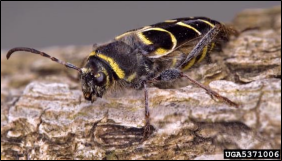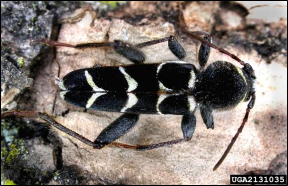Banded Ash Borer
ID
ENTO-133NP (ENTO-406NP)
Description
Adult banded ash borers have somewhat cylindrical, elongated bodies ranging from 8-18 mm (0.3-0.7 inches) long and tapered towards the tip of the abdomen. Adults are grayish-black in color with lighter colored hairs all over the body. There is an ivory to yellow colored band on the thorax directly behind the head and several bands across the wing covers (Fig. 1). The colored bands on the leading edge of the wing covers form loops joined along the midline while the other bands are wavy (Fig. 2). There are bands on the abdomen as well. The legs and antennae are reddish-brown.

Larvae are creamy white with a dark, round head capsule and constrictions between body segments that make them look lumpy. They measure approximately 10-22 mm (0.4-0.9 inches) long when mature. The pupa resembles a yellow mummy with the adult characteristics of legs, antennae, and head readily noticeable. Larvae and pupae are not likely to be noticed unless infested wood is being split.
Banded ash borer, Neoclytus caprea, belongs to the cerambycid family of beetles. Adult cerambycids are often called longhorn borers in reference to their long antennae. The larvae are known as roundheaded borers.

Life Cycle
Banded ash borer has a complete life cycle of egg, larval, pupal, and adult stages. Adults emerge from infested wood in early spring. Females lay eggs in cracks and crevices of bark on dying or recently dead host trees. Newly hatched larvae feed under the bark before tunneling into the wood, where they continue to feed until pupating. Larval tunnels are packed with sawdust-like frass. Banded ash borer may overwinter as either mature larvae or as pupae within the wood. Usually there is a single generation each year. Developmental times are probably drawn out in hardwood cut and seasoned for lumber or firewood as the moisture in the wood continues to decrease.
Damage
Banded ash borer favors ash, oaks, and hickories, but will attack almost all stressed, dying, or recently dead hardwood trees and even some newly planted trees. Egg-laying females are very attracted to newly-cut, green logs with the bark still attached, but not debarked logs. Larval tunneling in standing trees may weaken limbs, making them more susceptible to breaking in high winds. Economic damage by banded ash borer larvae is largely limited to hardwood intended for lumber or firewood.
Adults may be found in homes after emerging from firewood brought inside during the winter, where they can be a nuisance but do not cause structural damage to finished lumber or wood furniture. Firewood can be re-infested by newly-emerged adults over successive generations until the wood is no longer attractive to egg-laying females. Treating wood piles to control banded ash borer is not generally recommended due to the volume of insecticide necessary to treat all the surfaces of cut wood. Leaving the wood outside until needed and burning it in a timely fashion is a better choice.
Infestation by banded borer in ash can be confused with the emerald ash borer (Agrilus planipennis). Banded ash borer tunnels tend to meander and extend deep into the ash tree. The tunnels of the emerald ash borer are tightly S-shaped and restricted to the phloem directly under the bark of the ash tree. The exit holes of banded ash borer are round while those of the emerald ash borer are distinctly D- shaped.
Habitat and Distribution
Banded ash borer is a native species found wherever its wide host range occurs over much of the continental United States and into eastern Canada.
Control
Trees properly planted in a good site and maintained in good health are less susceptible to banded ash borer and similar pests. See the Virginia Pest Management Guide for Home Grounds and Animals (VCE 456-018), for chemical controls currently recommended for banded ash borer attacking standing trees. Thoroughly spray the bark of the trunk and larger branches with the selected material in late July and early September. This spray schedule will kill females laying eggs in cracks and crevices of the bark as well as newly hatched larvae chewing into the tree through the treated bark.
The systemic insecticides dinotefuran and imidacloprid can be applied as a preventative treatment against roundheaded borers before infestation occurs. Applied as soil drenches, these materials move up into the tree through the tree’s vascular system. They must be applied when the trees are actively growing and transpiring, and application must be early enough that sufficient quantities are translocated into the tree well ahead of when adults begin laying eggs on the tree. These insecticides may kill both the females chewing on the bark to form notches where they will lay their eggs as well as newly hatched larvae boring into the sapwood. Neither dinotefuran nor imidacloprid will have little effect on any roundheaded borer larvae already present in the tree’s heartwood.
Prune out infested limbs when borers are not active and dispose them properly so that adults do not emerge and re-infest nearby trees. Newly cut logs should be debarked and stored properly to avoid infestation. Treating wood piles with insecticide to control banded ash borer is not recommended.
Note
Banded ash borer should not be confused with the similarly-named banded ash clearwing moth, Podosesia aureocincta, which is also a pest of ash trees.
Revised
Theresa A. Dellinger, January 22, 2021.
Virginia Cooperative Extension materials are available for public use, reprint, or citation without further permission, provided the use includes credit to the author and to Virginia Cooperative Extension, Virginia Tech, and Virginia State University.
Virginia Cooperative Extension is a partnership of Virginia Tech, Virginia State University, the U.S. Department of Agriculture (USDA), and local governments, and is an equal opportunity employer. For the full non-discrimination statement, please visit ext.vt.edu/accessibility.
Publication Date
January 29, 2021



